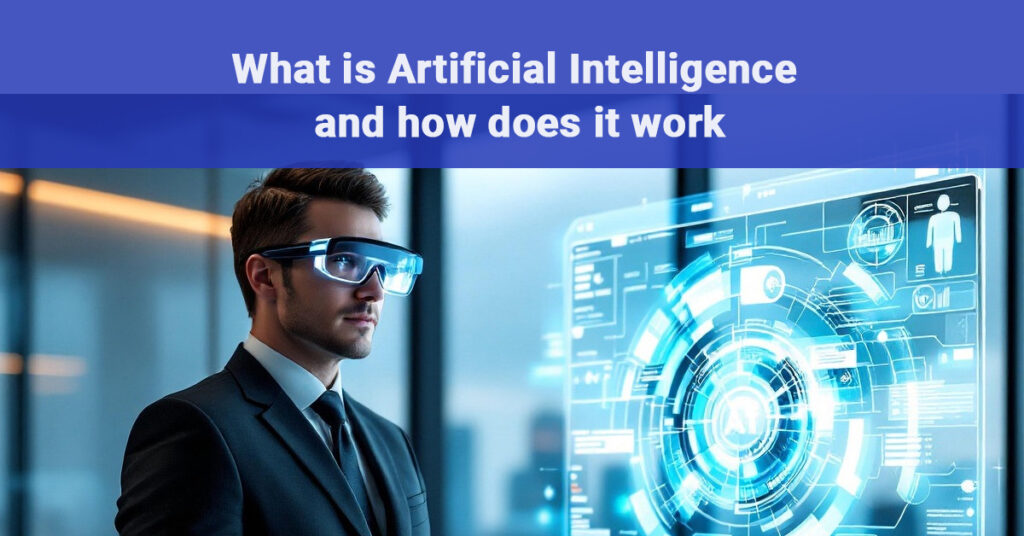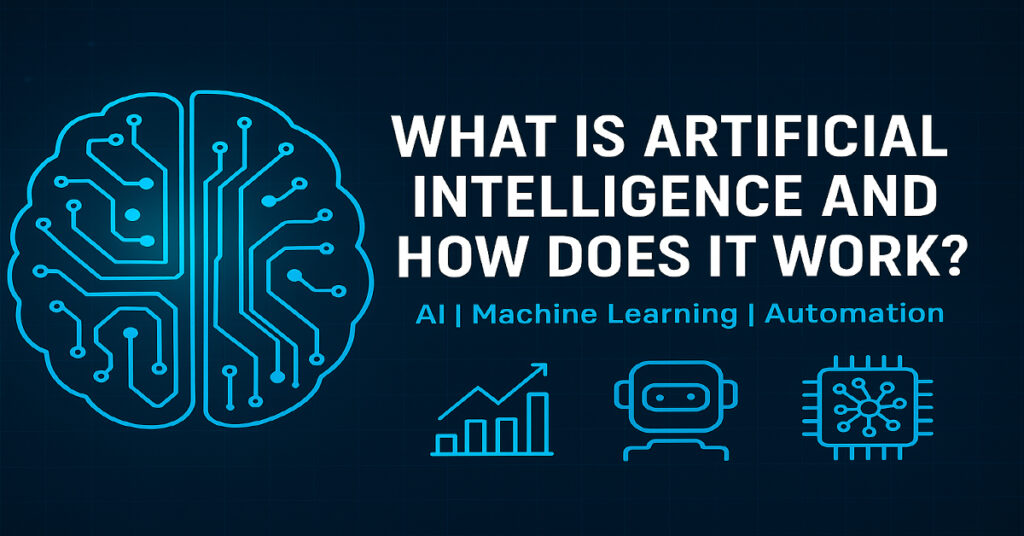What is Artificial Intelligence and How Does It Work?

Introduction
Artificial Intelligence (AI) is no longer just a futuristic concept seen in science fiction movies. Today, it is a powerful technology shaping the way we live, work, and interact with the world. From smartphones that recognize your voice to self-driving cars and automated customer service, AI has become an integral part of modern life. But what exactly is Artificial Intelligence, how does it work, and why is it so important for the future of industries and human society?
In this article, we will explore Artificial Intelligence, its relationship with machine learning, deep learning, and algorithms, and how it contributes to data analysis, pattern recognition, problem-solving, and automation.
What is Artificial Intelligence (AI)?
Artificial Intelligence refers to the simulation of human intelligence in machines that are programmed to think, learn, and act like humans. Unlike traditional software, AI systems can adapt, improve, and make decisions without constant human intervention.
The core idea of AI is to enable machines to perform tasks such as:
Understanding natural language
Recognizing images, speech, or patterns
Making predictions based on data
Automating repetitive processes
Solving complex problems
In short, AI aims to replicate certain aspects of human intelligence in machines, allowing them to perform cognitive functions with accuracy and speed.
How Does AI Work? The Role of Algorithms
At the heart of AI lies algorithms. An algorithm is a step-by-step set of instructions that a machine follows to achieve a specific outcome.
For example, when Netflix recommends a movie, it is following an algorithm that studies your previous choices, compares them with other users, and predicts what you might like.
AI algorithms are designed to process massive amounts of data, learn from it, and continuously refine their output. This ability to “learn by doing” makes AI smarter over time.
Machine Learning: Teaching Machines to Learn
Machine learning is a subset of AI that focuses on enabling machines to learn from data without being explicitly programmed.
Instead of telling a computer every rule, machine learning allows it to analyze examples, recognize patterns, and make decisions. For instance:
Email systems use machine learning to detect spam.
Banks use it to detect fraud.
E-commerce websites use it to recommend products.
The more data machine learning systems process, the better they become at predicting outcomes and making decisions.

Deep Learning: Taking AI to the Next Level
While machine learning works with structured data, deep learning goes deeper by mimicking the human brain through artificial neural networks.
Deep learning allows AI systems to handle complex tasks such as:
Speech recognition (like Siri or Alexa)
Image recognition (like Google Photos detecting faces)
Autonomous driving (self-driving cars detecting objects on the road)
These neural networks consist of multiple layers that process information in a way similar to how humans think and learn. That’s why deep learning is considered the most advanced form of AI.
Data Analysis and Pattern Recognition
The true power of AI lies in its ability to perform data analysis at lightning speed.
In today’s digital world, billions of pieces of data are generated every second — from social media posts to financial transactions. AI systems can analyze this vast data, extract meaningful insights, and predict future trends.
For example:
Businesses use AI-driven data analysis to understand customer behavior.
Hospitals use it to predict patient outcomes.
Governments use it for smart city planning.
Alongside data analysis, AI excels at pattern recognition. It can detect hidden patterns that humans might overlook, making it invaluable in areas like cybersecurity, healthcare, and market forecasting.
AI Problem-Solving and Automation
One of the most exciting applications of AI is its ability to solve problems and drive automation.
In industries, AI-powered robots streamline manufacturing processes.
In finance, AI helps in risk assessment and fraud detection.
In healthcare, AI assists doctors in diagnosing diseases faster and more accurately.
In customer service, chatbots provide instant responses 24/7.
Automation powered by AI not only saves time but also reduces human error, increases efficiency, and allows people to focus on more creative and strategic tasks.
The Future of Artificial Intelligence
The future of AI is bright and full of opportunities. As technology continues to evolve, AI will play an even greater role in:
Education (personalized learning)
Transportation (smart cities, self-driving vehicles)
Medicine (AI-powered drug discovery)
Business (hyper-automation and intelligent workflows)
However, with these opportunities come challenges, such as data privacy, job displacement, and ethical concerns. Balancing innovation with responsibility will be key to ensuring that AI benefits humanity as a whole.
Conclusion
Artificial Intelligence is more than just a technological trend — it is a revolution that is transforming every aspect of life. From machine learning and deep learning to algorithms, data analysis, pattern recognition, and automation, AI is unlocking new possibilities for industries, businesses, and individuals worldwide.
Frequently Asked Questions (FAQs)
1. What is Artificial Intelligence in simple words?
Artificial Intelligence is the ability of machines to mimic human intelligence, such as learning, problem-solving, and decision-making.
2. How does AI use machine learning and deep learning?
AI uses machine learning to learn from data and improve predictions, while deep learning uses neural networks to process complex tasks like speech and image recognition.
3. Why are algorithms important in Artificial Intelligence?
Algorithms guide AI systems to analyze data, recognize patterns, and make accurate decisions, acting as the foundation of AI technology.
4. How is AI used in data analysis and pattern recognition?
AI can process massive amounts of data, detect hidden patterns, and provide valuable insights for industries like healthcare, finance, and marketing.
5. What are some real-life applications of AI problem-solving?
AI is used in fraud detection, medical diagnosis, autonomous vehicles, customer service chatbots, and industrial automation to solve problems effectively.
6. Will AI automation replace human jobs?
AI automation will replace some repetitive tasks but also create new opportunities in AI development, data science, and technology-driven industries.
7. What is the future of Artificial Intelligence?
The future of AI includes smarter automation, self-driving cars, personalized education, medical breakthroughs, and advanced smart city innovations.